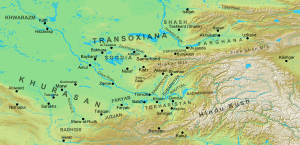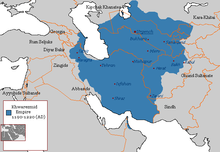Khwarazmshah
Khwarazmshahwas an ancient title used regularly by the rulers of theCentral Asianregion ofKhwarazmstarting from theLate Antiquityuntil the advent of theMongolsin the early 13th-century, after which it was used infrequently. There were a total of four families who ruled as Khwarazmshahs—theAfrighids(305–995),Ma'munids(995–1017), the line ofAltuntash(1017–1041), and the most prominent ones, theAnushteginids(1097–1231).[1][2]Like other contemporary Central Asian titles, such asAfshinandIkhshid,the title of Khwarazmshah is ofIranianorigin.[3]
History
[edit]Afrighids
[edit]
Most of Afrighid history was recorded by the Khwarazmian scholaral-Biruni(died 1050), whose reliability has been questioned. According to the latter, the Afrighids were founded byAfrigin 305, succeeding the semi-legendary line of the Siyavushids, founded by the Iranian kingKay Khosrow.However, extensiveSovietarcheological findings demonstrate that al-Biruni was in reality not well-acquainted with pre-Islamic Khwarazmian history. Coin findings show that before the advent of the Afrighids, Khwarazm was part of theParthian Empire.The start of theKhwarazmian eraseemingly took place in the early 1st-century, after they had freed themselves of Parthian rule, and established their own local dynasty of shahs. The dynastic name of "Afrighid" (Khwarazmian:ʾfryḡ) is not attested anywhere besides al-Biruni, which has led scholars to suggest that the name never existed. Likewise, many of the Khwarazmshahs recorded by al-Biruni are not supported by archeological evidence; however, this may be due to scribal errors.[3][2]
The Afrighids and the local population were most likely adherents ofZoroastrianism.[2]The first Khwarazmshah to convert toIslamwasAzkajwar-Abdallah,who ruled in the early 9th-century, perhaps coinciding with the reign of theAbbasidcaliphal-Ma'mun(r. 813–833). Regardless, the Islamization of the local population was much slower. In the early 10th-century, the Khwarazmshahs were made vassals of theSamanid dynasty,[4][2]aPersianfamily which ruled mainly inTransoxaniaandKhurasan.[5]Although the Khwarazmshahs sometimes granted sanctuary to Samanid rebels, they generally ruled a peaceful domain. During the end of the Samanids, the Khwarazmshahs extended their rule as far as the northern edges of Khurasan, ruling frontier posts such as Farawa andNasa.[4]
An uncertain part of Khwarazmian history is the rise ofMa'munid family,who came to rule their hometown ofGurganj,one of the three main cities of the country. The city had risen to rival the Afrighid capital ofKath,most likely due to its commercial success as a trading post between thesteppeand theKievan Rus'.The Ma'munids and Afrighids eventually became rivals, with conflict soon ensuing. The Ma'munidMa'mun Ideposed and killed the Afrighid shahAbu 'Abdallah Muhammad(r. 967–995), thus marking the end of the first Khwarazmshah line of the Afrighids, and the inauguration of the second Khwarazmshah line of the Ma'munids.[4]
Ma'munids
[edit]
Under the Ma'munids, their capital of Gurganj became a centre of learning, attracting many prominent figures, such as the philosophersAvicennaandAbu Sahl al-Masihi,the mathematicianAbu Nasr Mansur,the physicianIbn al-Khammar,and thephilologistal-Tha'alibi.The Ma'munids also embellished their capital with buildings such as aminaretwhich still survives till this day, and has an inscription creditingMa'mun II(r. 1009–1017) its founder. However, the Ma'munids soon fell into conflict with theGhaznavidSultanMahmud(r. 999–1030), who sought to pressurize hisQarakhanidenemies by extending his rule into Khwarazm. In 1014, Mahmud demanded that Ma'mun II should add his name in thekhutba(Friday sermon) in Khwarazm, thus acknowledging his suzerainty. Unable to gain military assistance or appease Mahmud through other means, Ma'mun II was forced to accept his demands, much to the dislike of the Khwarazmian nobles and military officers.[4][6]
This eventually resulted in a patriotic revolt, led by the commander-in-chief Alptigin, which led to the murder of Ma'mun II and accession of his nephewAbu'l-Harith Muhammadin March 1017. Ma'mun II was the brother-in-law of Mahmud, which afforded the latter a pretext to invade Khwarazm. The Ghaznavid army defeated the local Khwarazmian forces atHazarasp,brutalized the population of Gurganj, and captured many Khwarazmians, who were taken to the capital ofGhaznias slaves. Abu'l-Harith Muhammad was deposed and imprisoned, while Khwarazm was incorporated into the Ghaznavid realm, thus marking the end of the Ma'munid dynasty, the last ethnically Iranian line of Khwarazmshahs.[4][6]
The line of Altuntash
[edit]Due to the difficulty to control a distant area such as Khwarazm, Mahmud installed hisTurkicslave commander (ghulam)Altuntashas the governor of the region, with the traditional title of Khwarazmshah, thus marking the start of the third line of Khwarazmshahs.[7][6]A loyal servant of the Ghaznavids, Altuntash protected the borders of Khwarazm by enlisting additional soldiers from the Turkic groups ofQipchaq,Kujet and Chaghrat. He died of wounds in the aftermath of theBattle of Dabusiyyaagainst the Qarakhanid rulerAli-Tigin(r. 1020–1034) in 1032. Although SultanMas'ud I(r. 1030–1040) appointed his own son Sa'id as the new Khwarazmshah, thede factoruler of Khwarazm was Altuntash's sonHarun,who was thekhalifat al-dar(lieutenant) of Sa'id. In 1034, in an alliance with theSeljuk Turks,Harun rebelled against Mas'ud, but was the following year assassinated at the instigation of the latter. Harun was succeeded by his brotherIsmail Khandan,who was able to rule as an independent monarch as Mas'ud I was occupied with the Seljuk invasions. In 1038, Mas'ud gave the governorship of Khwarazm to his ally,Shah Malik,theOghuz YabghuofJand.In 1041, Ismail was expelled from Khwarazm by the latter, who declared himself ruler at Gurganj, thus marking the end of the Altuntash line. During this period, however, Mas'ud had already died and Ghaznavid rule in the west had crumbled.[8][9]
Anushtegin dynasty
[edit]
A year after Shah Malik's conquest of Khwarazm, he was expelled by the Seljuk leadersTughrilandChaghri Beg.From henceforth Khwarazm was a Seljuk province, although the title of Khwarazmshah was unused untilc. 1077,when the TurkicghulamAnushtegin Gharchaiwas made its governor by SultanMalik-Shah I(r. 1072–1092). He was succeeded by fellow TurkicghulamEkinchias Khwarazmshah in 1097, but the latter died in the same year. SultanBerkyaruq(r. 1094–1105) then made Anushtegin's son Qutb al-Din Muhammad (who became known asMuhammad I) the new Khwarazmshah, thus marking the start of thefourth and final Khwarazmshah lineof theAnushteginids.[8][10]
Muhammad I was loyal to the Seljuks, attending the Seljuk court with diligence. It was his son and successorAtsiz(r. 1127/8–1156) who established the Khwarazmshahs' grandeur, being determined in his pursuit of autonomy and expansion of his realm, conquering theTurkmensof the easternCaspian shoresand theManghislak peninsula.Regardless, he nominally acknowledged the suzerainty of SultanAhmad Sanjar(r. 1118–1157) till the end of his reign. Atsiz's son and successorIl-Arslanwas able to gain greater autonomy after the death of Sanjar and disintegration of Seljuk authority in the east. As long as he paid tribute to theQara Khitai,they had little interest in meddling in his affairs, and thus he was free to focus on expanding his rule into the Qarakhanid domains.[8]
The power of the Khwarazmshahs even further increased under Il-Arslan's son and successorAla al-Din Tekish(r. 1172–1200) was able to slow down theGhuridexpansion into Khurasan and destroy the Seljuk Empire. Furthermore, he also declared independence against his Qara Khitai suzerains, whose attacks he repelled. At the time of his death, his realm stretched as far asPersian Iraqto the west. His son and successorMuhammad II(r. 1200–1220) was occupied with his rivals in the east (Ghurids, Qara Khitai, the Qipchaq of the northern steppes, and the Qarakhanids) for much of his reign. He initially maintained cordial relations with the Qara Khitai, who helped him fend off the 1204 invasion of Khurasan by the Ghurid rulerMu'izz al-Din Muhammad Ghuri(r. 1173–1206), who later died in 1206. His death led to the disintegration of his empire, and Khwarazmian conquest over much of it.[8]
He could now distance himself from the Qara Khitai, and while the latter were preoccupied by the revolt of the Mongol leaderKuchluginSemirechye,Muhammad II capitalized on this by defeating and killing the Qarakhanid leader Uthman Khan, thus putting an end to Qarakhanid rule in Transoxiana.[11]Muhammad II was now a towering figure in the eastern Islamic world, but like his father, was content with the limited titles of Khwarazmshah and Sultan. He now sought to the deal with the Abbasid Caliphate, who had in the past supported the Ghurids against him; he marched towardsBaghdad,but the extreme weather conditions during the winter and unrest amongst the Qipchaq forced him to return to Khwarazm. His son and successorJalal al-Din Mangburni(r. 1220–1231) was unable to contain theMongol invasions,which led to the collapse of the Khwarazmian Empire.[12]
Aftermath and Final Usage
[edit]The title of Khwarazmshah was seemingly unused by the Mongol governors of Khwarazm and the laterSufi dynasty.It was revived under theTimurid Empire,after which it was infrequently used, such as under Shah Malik, the governor of Khwarazm underShah Rukh(r. 1405–1447) and Shah Malik's son, Nasir al-Din Sultan Ibrahim. The title was informally used by theUzbekArabshahidand later dynasties ofKhivain various literary works but never officially adopted.[12]
The final official use of the title was underEltuzar-Inak– the founder of theQungratline (1804-1920) of theKhans of Khiva– who titled himselfWāriṯẖ-i Kẖwārazm-Sẖāhān( "Heir of the Khwarazmshahs" ) on his coins, however he died in 1806 before they could ever be issued.[12]
References
[edit]- ^Bosworth 1978,pp. 1065–1068.
- ^abcdBosworth 1984a,pp. 743–745.
- ^abBosworth 1978,p. 1065.
- ^abcdeBosworth 1978,p. 1066.
- ^Bosworth & Crowe 1965,pp. 1025–1027.
- ^abcBosworth 1984b,pp. 762–764.
- ^Bosworth 1978,pp. 1066–1067.
- ^abcdBosworth 1978,p. 1067.
- ^Bosworth 1989,pp. 914–915.
- ^Bosworth 1986.
- ^Bosworth 1978,pp. 1067–1068.
- ^abcBosworth 1978,p. 1068.
Sources
[edit]- Bosworth, C.E.& Crowe, Yolande (1965)."Sāmānids".InLewis, B.;Pellat, Ch.&Schacht, J.(eds.).The Encyclopaedia of Islam, Second Edition.Volume II:C–G.Leiden: E. J. Brill.OCLC495469475.
- Bosworth, Clifford Edmund (1968). "The Political and Dynastic History of the Iranian World (A.D. 1000–1217)". InBoyle, John Andrew(ed.).The Cambridge History of Iran, Volume 5: The Saljuq and Mongol Periods.Cambridge:Cambridge University Press.pp. 1–202.ISBN0-521-06936-X.
- Bosworth, Clifford Edmund (1978)."K̲h̲wārazm-S̲h̲āhs".Invan Donzel, E.;Lewis, B.;Pellat, Ch.&Bosworth, C. E.(eds.).The Encyclopaedia of Islam, Second Edition.Volume IV:Iran–Kha.Leiden: E. J. Brill.OCLC758278456.
- Bosworth, Clifford Edmund (1984a)."Āl-e Afrīḡ".Encyclopaedia Iranica, Vol. I, Fasc. 7.pp. 743–745.
- Bosworth, Clifford Edmund (1984b)."Āl-e Maʾmūn".Encyclopaedia Iranica, Vol. I, Fasc. 7.pp. 762–764.
- Bosworth, Clifford Edmund (1986)."Anuštigin Ĝarčāī".Encyclopaedia Iranica.
- Bosworth, Clifford Edmund (1989)."Altuntaš".InYarshater, Ehsan(ed.).Encyclopædia Iranica, Volume III: Ātaš–Bayhaqī, Ẓahīr-al-Dīn.London and New York: Routledge & Kegan Paul. p. 915.ISBN978-0-71009-121-5.
- Bosworth, Clifford Edmund (2008)."Khwarazmshahs i. Descendants of the line of Anuštigin".InYarshater, Ehsan(ed.).Encyclopædia Iranica, Volume XIV: Isfahan IX–Jobbāʾi.London and New York: Routledge & Kegan Paul.ISBN978-1-934283-08-0.
